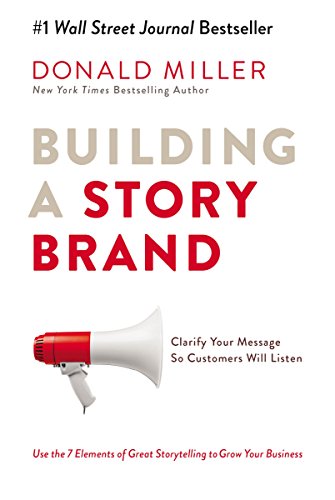Continuing the journey to positioning, and online income. This time reviewing ” Building A StoryBrand ” the goal of which is to help overcome overcluttering in your Marketing, written by Donald Miller. Through explaining the principles of story narratives as they are used since something like the dawn of humanity and until modern times, Donald gives us a framework that helped thousands of business leaders clarify their message, and avoid producing noise.
You can get it here(US) or here(UK)


Opening Credits ( 00:02:52 )
1. The Key to Being Seen, Heard, and Understood ( 00:18:46 )
2. The Secret Weapon That Will Grow Your Business ( 00:18:43 )
3. The Simple SB7 Framework ( 00:19:21 )
4. A Character ( 00:18:35 )
5. Has a Problem ( 00:25:00 )
6. And Meets a Guide ( 00:18:37 )
7. Who Gives Them a Plan ( 00:13:17 )
8. And Calls Them to Action ( 00:18:21 )
9. That Helps Them Avoid Failure ( 00:12:56 )
10. And Ends in a Success ( 00:17:40 )
11. People Want Your Brand to Participate in Their Transformation ( 00:15:51 )
12. Building a Better Website ( 00:16:49 )
13. Using StoryBrand to Transform Company Culture ( 00:21:00 )
The StoryBrand Marketing Roadmap ( 00:54:54 )
End Credits ( 00:03:16 )
Attributes of The Book
Objective parameters of the book
Author
Donald Miller – CEO of Storybrand, an organisation that helps 3000 business owners yearly in clarifying their message. He is also an author of multiple books. Though according to Wikipedia, only the last 2 are about marketing.
Book Length
Audio – 4hrs 56min / Physical – 240 pages
Reviews
As of writing the blog post 4.7 out of 5.00 average out of 1908 ratings at amazon.com
Subject
Marketing, Business & Career.
Awards/Achievements
Currently #1 bestseller in Direct Marketing , Product Management and Business Writing Skills categories of books on Amazon.com.
And #2 bestseller in Product management, Customer Services, and #3 in Advertising(Books) at Amazon.co.uk
Decision Process

What helped me choose, and may help you.
Length
As I have deadlines the length is important to me, and a 5 hour long book is great by that term.
The ammount of books I listen to on the subject
Knowing that I am going to listen to a lot of other books on the subject, and that probably I am going to read all the big ones, makes it easier, because I’m probably going to get through it sooner or later if it’s big, and also, if I choose an uninteresting book, there’s always the next one coming right after.
Reviewed by other influencers
I saw other influencers review it earlier, further proving me that It is a widespread book, and adding social proof.
Suggested on amazon together with other great marketing books
Suggested alongside The 1-page marketing plan, must be good then, right? 🙂
Social Proof and Reviews on Amazon
Basically there are tons of reviews on amazon and most of them positive, by the way the Social proof principle is one of the 6 principles of the book Influence by Robert B. Cialdini.
Main Ideas of the Book in a Nutshell

Be Clear and Tell Stories
Be Clear
Use less words, that show a clear picture right off the bat.
Don’t have the customers thinking too much, when they think – they burn calories, and their brain has a mechanism that is designed to stop them from burning too many, in order to help them survive.
Tell Stories
The most effective way to capture the audiences attention is by telling an enticing story, because story is a mechanism that brings information to the brain in a chewed up form, customers don’t have to think, they just consume it, and are reluctant to get away from it.
The SB7 Storytelling Framework

The SB7 Framework stands for 7 steps in building a StoryBrand brandscript. Shortly it may be described like this:
A Character who wants something, encounters a problem.
He then meets a guide, who gives them plan and calls them to action , that helps avoid failure, and end with success.
Think of it. Almost every bestseller movie you watch has this storyline.
What does this have to do with Marketing?
Well, every brand tells a story, and for the story to be successful and engaging it should possess those 7 parts. So what exactly should we know about each of those principles? I’ll tell you briefly.
Building a StoryBrand principle 1: A character who wants something.
First thing we have to do is determine what does our character want. This is usually done within 9 minutes of the beginning of any movie or else, the audience loses interest. And we should do this while building a storybrand too!
P.S. Let me know how vague I am with this on a scale from 1 to “I have no Idea what your site is about” in the comments below 🙂 By the way with brands, the hero is you, the audience, not the brand.
Building a StoryBrand principle 2: Encounters a problem
In every plot there is a conflict, something, some object that stops the character from achieving what he wants. This is as ingrained as ABC. No problem – no plot. This problem sometimes also comes in the form of a villain. To further clarify: Imagine the Batman without the Joker.
Building a StoryBrand Principle 3: And meets a guide
Our hero almost always doesn’t know how to solve the problem when he encounters it, if he knew, it wouldn’t be a problem in the first place. That’s where the guide comes in.
In our case of building a StoryBrand – The guide is the brand.
Building a StoryBrand Principle 4: Who gives them a plan
Every guide must have a plan, the hero has to trust that the guide knows how to bring him to where he needs and wants to be, step by step. It is not enough for the guide just to say: “Go to the other side of the river”, he should also explain which stones should the hero step on, on the way there.
Building a StoryBrand Principle 5: And calls them to action
The hero must be challenged. Nobody gets to great achievements if they have no good reason for it, something that puts them out of balance.
While building a StoryBrand this translates into having a clear message of what you want the audience to do, whether that be placing an order, making a call, setting an appointment or something else. If you don’t call them to action, they’ll be confused about what you want from them, and not engage.
Building a StoryBrand principle 6: That helps avoid failure
Every human being wants to avoid a tragic ending, every moment in the plot revolves around whether the character is getting closer to failure or success.
When building a storybrand, we should point out what horrible thing will happen if they do not engage, we shouldn’t just run wild with scaring them to no end, rather, show them what’s at stake if they don’t take action. If there’s no risk, nobody will care, imagine in a movie the hero would have to disarm a bomb that wouldn’t harm anyone if it went off. It’s the same here, if they have nothing to lose, they have no reason to act.
Building a StoryBrand principle 7: And end with success
This is often the climactic scene, the ending. Where all of the heroes problems are solved, and we remember it for long after with a sigh of relief.
While building a storybrand you should likewise paint an image of the ideal situation to which the audience would like to arrive.
The 8th step - Transition
Despite the fact that it is called the SB7 framework there’s another thing that is extremely important in a story, and that is the power of change. Everyone wants to become a better, improved version of themselves. The main difference between this principle and the success principle is that in the success principle – you show the audience where they’re going to get, and here – you show them who are they going to be when they get there.
Can't wait to start building a storybrand?
Start building a storybrand with Donald Miller’s book!
Amazon UK – https://amzn.to/2HIhEYZ
Amazon US – https://amzn.to/37ajxGM
You could also get a PDF about the 4 Self-Improvement books that rocked my world. For FREE of course.
5 Steps to apply to your website

Here are 5 practical steps by which you could apply the “building a StoryBrand” formula to your website
1. An Offer above the fold
Above the fold – means when someone enters your website, before starting to scroll down.
An offer – means explaining what you do as clearly and shortly as possible.
For Example: Currently my phrase on the homepage is “Work hard and Achieve Your Goals” but it is vague and I am working on changing it.
2. Obvious call to action
Place your Call to Action as a button that stands out on top right of your website and above the fold in the middle.
3. Images of success
An example of that is people smiling while using your product.
When saying images – the intention is actual photos.
4. A bitesized breakdown about your revenue streams
Have a breakdown for people who come to your site for different reasons. For example: If someone sells insurances for cars and homes, he could put relevant buttons to redirect each customer to the relevant content.
5. Very few words
Be as concise and clear as possible, everything that doesn’t serve as a promotion to building a StoryBrand, should be deleted.
5 Story Brand road map tasks

1. Create a one-liner for your company
This should be like an elevator pitch but containing only certain parts from the brandscript. It should be included in all your messaging, very enticing and inviting to your story, like a logline (a line that concisely summarizes the story in a movie).
2. Create a lead generator and collect Email adresses
Don’t just ask for subscriptions, offer something valuable in return, this something may come in lots of forms, some of the most common ones are PDF and Video Courses.
3. Create automated mail drip campaign
Creating an automated mail sequence is like hiring sales people that will work while you sleep. It will keep sending people mails automatically, at the times you’ve set.
4. Collect and tell stories of transformation
Don’t just ask your customers to tell their story if they’ve enjoyed your service. Rather, invite them to answer a series of specific questions, questions from the SB7 framework that will contribute to building a StoryBrand.
5. Create a system that generates referrals
As in the 1-Page Marketing Plan , the ” building a StoryBrand ” Roadmap pushes you toward having a supervised process for referrals, not depending on luck.
Offering an explanatory video, coupons for friends, or other benefits to customers are a few of the tools you could use to generate referrals.
Using StoryBrand to transform company culture




You should have a seperate ” Building a StoryBrand ” brandscript for the employees in your company and the customers. When having a story that is actually a part of the organization, the life of the employees becomes a thrilling adventure rather than a boring job, and it gets the best out of them.
When they know how important their job is in the effort to solve the customer’s problem, it all looks completely different. But, obviously, you have to walk the talk, not just have a mission statement that is read once a month.
Takeaways / Implementations
It is quite simple
The author explains exactly how we should implement the book in order to be building a storybrand.
We should fill out the brandscript, then turn to the 5 steps to include in the website, and afterwards do the 5 roadmap tasks. It could all together take months or even years, but eventually will be worth the effort.
5 things to be more specific
Those are 5 of the things I believe I should apply after reading “Building a StoryBrand”,
1. Create a Book Consulting offer – No offer, no business. My current one is Audible Free Trial, but from what I’ve figured out there should also be an offer with a price tag.
2. Replace the button “About Author” with a Call to Action Button, which will be a free trial consulting session.
3. State specifically what do I offer on this blog, put it above the fold.
4. Create a one-liner that will stick.
5. Create a better lead magnet that would fit the audience better.
My general experience of the book
Movies are powerful
Another great book, from which I’m sure Allan Dib – the author of the 1-Page Marketing Plan took some of his Ideas.
Inside it, it has the key to how movies capture the audience’s attention.
Imagine what power one has when using this knowledge.
The more I hear certain principles - The more I know they're right
Though some principles I already heard – It is always worth hearing them repeated, as long as I haven’t applied them, and even being reminded of them after I have.
Aspecially when those principles come from another person’s perspective, aspecially one as successful as Donald Miller (Apparently).
The things that cause me to procrastinate on Implementation
In order to apply the principles here,
what is most important to cope with, is the Technitian’s tendency to take over. Explained in The E-Myth: Revisited review .
And, still, Ironically, with the delivery on my deadlines, which, as you can see I missed this time. For that part I’m currently experimenting with The Pomodoro Technique. Together with the time-boxing technique that is discussed in Indistractable
Conclusion and Rating
Conclusion
Building a StoryBrand by Donald Miller is providing an enticing framework to build narratives.
It does so in a clear way, and also provides additional specific tasks to complete in order to apply it to your own brand.
The book also explains how to bring the spirit back into employees, and puts a general roadmap for us to apply on the way to building a StoryBrand.
100-Scale Rating
Narration
Examples
Storyline/Plot
Headline Division
Content
Drive to Implicate
Final Rating
If you confuse, you'll lose
Acquisition options
Engage in building a StoryBrand with Donald’s SB7 framework.
Get awesome Bonus PDF with 8 Audible Moneysaving Tricks and Tips.

Decided to get “Building a StoryBrand” through the Amazon links above or with audible trial? Awesome! Let’s save you a bunch of money with this PDF! Just fill in the form or alternatively send me a mail to yan@improvementor.blog with your Order Number and I’ll send you the PDF as soon as possible (Usually within 24 hours)
YouTube Review
Related Articles

7 Steps To Freedom S2-C5: Finding Demanded Products (7)
What makes a product awesome? How to find an existing marketable product? How to find an audience and make a product for them? How to test

7 Steps To Freedom S2-C2-4: Boring Essentials (6)
Glossaries are essential for understanding what is said, but most people arguably consider them “boring”.I’ve taken the interesting and important parts of the glossary of

7 Steps To Freedom S2-C1: 4 Content Lessons from Selling a Birdhouse (5)
What 4 content creator lessons may we draw in 2025 from a marketing success story of a birdhouse salesman in 1994? – Inspired by 7


